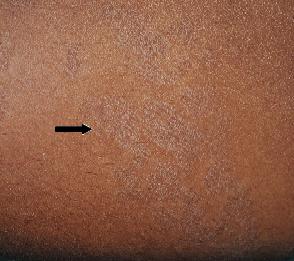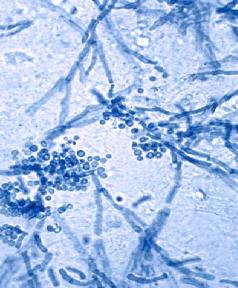What is pityriasis versicolor?
It is a common superficial skin infection caused by yeasts of the genus Malassezia. The yeasts are usually found on sebum(lipid)-rich areas of the body such as the trunk, back, face and scalp. Malassezia furfur yeasts are part of the normal skin flora which may cause infection under certain conditions.
How does it present?
The lesions are most commonly found on the upper trunk, upper arms and neck, which are lipid-rich areas of the body. They present as patches which may be pale (white, pink) or dark (tan, brown, black) with some flaking on the surface. They may be round or oval, and confluent in more extensive lesions. Itchiness may be present in some cases.
These photos illustrate the variations in colour (Black Arrow)
 |
 |
 |
 |
 |
Who gets pityriasis versicolor?
Although pityriasis versicolor can occur at any age, it is more common in the adolescents and young adults. Those with malnutrition or on systemic corticosteroids and immunosuppressants, as well as hyperhidrosis (excessive sweating) are also predisposed to developing the infection.
How is it diagnosed?
The diagnosis is usually made clinically from the characteristic appearance and confirmed by microscopy. This involves collecting samples by scraping or stripping off the scales with a cellophane tape. The characteristic ‘spaghetti and meatball’ appearance is indicative of the presence of hyphae and spores. A Wood’s lamp (filtered ultraviolet light with a peak of 365nm) may show a yellowish fluorescence of the affected areas in some cases.

Spaghetti and meatball’ appearance of hyphae and spores when examined under the microscope.
Is it contagious?
No. Most adults have the yeasts on the skin but do not have problems at all.
How common is it?
It is very common in the tropical countries with an incidence as high as 40%.
How is it treated?
Pityriasis versicolor can be treated with either topical agents or oral antifungals. Topical agents are generally safe and include nonspecific agents and topical antifungals.
Nonspecific agents:
- 2.5% selenium sulphide shampoo
- Propylene glycol
- Whitfield’s ointment
Topical antifungal agents:
- Topical azoles such as clotrimazole, miconazole, ketoconazole, econazole and tioconazole in different formulations
- Terbinafine cream or 1%solution
Oral antifungals are given to patients with extensive lesions, repeated infections or failed topical treatment. These should only be prescribed by the attending dermatologist/physician due to their potential side effects and possible drug interactions. Oral antifungals include itraconazole, fluconazole and ketoconazole.
Can it be cured?
Yes. Most patients are cured with the treatment described. However patients who have pale patches may often have to wait for months or years before the skin colour comes normalised. This does not mean that the treatment does not work. The yeasts produce chemicals that are toxic and inhibit the function of the pigment cells during the active infection. This may take some time to recover.
How to prevent further episodes/recurrences?
The recurrence rate of pityriasis versicolor may be as high as 60% in the first year. Selenium sulphide shampoo may be applied on a monthly basis to prevent this. Sometimes taking oral antifungal for one day or up to three days a month may also help.
| Last Reviewed | : | 23 August 2019 |
| Writer | : | Dr. Noorlaily Mohd Noor |
| Accreditor/Reviewer | : | Datin Dr. Asmah bt. Johar |
| Reviewer | : | Dr. Nazatul Shima bt. Abd Rahim |







